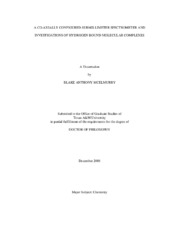| dc.description.abstract | The development of a co-axially configured submillimeter spectrometer is
reported. The spectrometer has been constructed to observe molecular complexes that
exhibit non-covalent interactions with energies much less than that of a traditional
covalent bond. The structure of molecular complexes such as those formed between a
rare gas and a hydrogen halide, Rg:HX where Rg is a rare gas (Rg=Ne, Ar and Kr) and
HX (X=F, Cl, Br and I) can be determined directly and accurately. The center of mass
interaction distance, RCM, as well as the angle of the hydrogen halide is determined,
along with direct evaluation of the intermolecular vibrations as well as accurate
isomerization energies between the hydrogen bound and van der Waals forms. The
accuracy of the frequency determination of rovibrational transitions using the
submillimeter spectrometer is also evaluated by direct comparison with the state-of-theart
pulsed nozzle Fourier transform microwave spectrometer, and this accuracy is
estimated to be less than 1 kHz at 300 GHz.
The tunneling or geared bending vibration of a dimer of hydrogen bromide or
hydrogen iodide has been investigated. The selection rules, nuclear statistics and intensity alternation for transitions observed in these dimmers, which is a consequence
of interchanging two identical nuclei in the low frequency geared bending vibration of
the molecular complex, are reported. Furthermore, the rotation and quadrupole coupling
constants are used to determine a vibrationally averaged structure of the complex. The
energy of the low frequency bending vibration can then be compared with ab initio
based potential energy surfaces.
A study of the multiple isomeric forms of the molecular complex OC:HI is also
presented. Multiple isotopic substitutions are used to determine the relevant ground state
structures and data reported evidence for an anomalous isotope effect supporting a
ground state isotopic isomerization effect.
All spectroscopic data that has been reported here has been additionally used to
subsequently model and generate vibrationally complete morphed potential energy
surfaces that are capable or reproducing the experimentally observed data. The utility of
this procedure is evaluated on a predicative basis and comparisons made with newly
observed data. | en |


